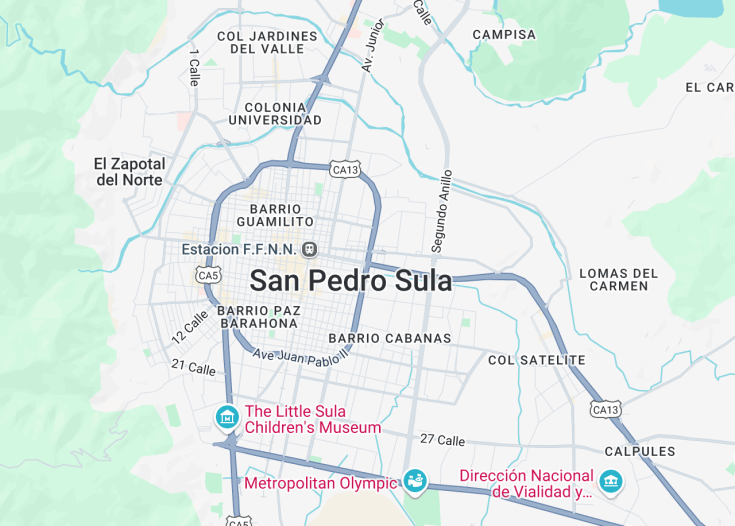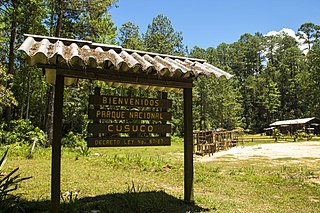San Pedro Sula, nestled in the lush Sula Valley of Honduras, serves as a vibrant economic and logistical hub. Known as the “Industrial Capital of Honduras,” it boasts a dynamic business environment alongside rich cultural offerings. Travelers can explore diverse markets, bustling plazas, and an array of local cuisine. The city’s strategic location makes it a gateway to the Caribbean coast and the ancient ruins of Copán, providing a perfect blend of urban excitement and historical exploration.
Planning a trip to San Pedro Sula? Make sure to visit the Mercado Guamilito, renowned for its handcrafts and local food delicacies—a colorful taste of Honduran culture.
For those visiting San Pedro Sula, consider a day trip to the nearby Pulhapanzak Waterfall. Its breathtaking views provide an excellent opportunity for photography and reconnecting with nature.
Top things to do & see in San Pedro Sula
Select the following sights and activities to discover best tickets and tours available in San Pedro Sula.
San Pedro Sula: Gateway to Nature and Culture
| Country | Honduras |
| Time in San Pedro Sula | GMT-6 |
| Language spoken | Spanish |
| Population | 719,063 (source: World Population Review) |
| Currency | Honduran lempira (L, HNL) |
| Airports |
|
San Pedro Sula, often referred to as the industrial heartbeat of Honduras, is a vibrant city where commerce meets tradition. Located in the Sula Valley at the northwest corner of Honduras, it serves as a vital hub for both the agricultural and manufacturing sectors. The city’s bustling markets and burgeoning business make it a bustling metropolis during the day and a cultural beacon by night.
The rich historical tapestry of San Pedro Sula dates back to its founding in the 16th century by Spanish conquerors. Its strategic location made it an agricultural and transportation center, which facilitated its growth beyond a typical colonial city. In contemporary times, San Pedro Sula has been pivotal in Honduras’s economic landscape, hosting numerous international businesses and factories.
The cultural landscape of San Pedro Sula is equally compelling. Known for its lively festivals that showcase traditional music and dance, it offers a profound glimpse into the heritage of Honduras. Museums in the city, such as the Museum of Anthropology and History, display artifacts that paint a picture of a rich pre-Colombian and colonial past.
Nature enthusiasts will appreciate the city’s proximity to natural reserves and national parks, where the biodiversity of Central America is at a stone’s throw. From bird watching to hiking, the outdoors provide a needed respite from the bustling city life.
Despite its challenges, San Pedro Sula remains an essential chapter in the narrative of Honduras, providing insights into the economic, cultural, and natural aspects that define this Central American nation.
Where is San Pedro Sula?
San Pedro Sula is nestled in the Sula Valley in northwest Honduras, serving as a crucial junction connecting various Central American economies.
Distances:
| Route | Distance by car | Time by car |
|---|---|---|
| Tegucigalpa to San Pedro Sula | 126 miles | 3 hours, 30 minutes |
| La Ceiba to San Pedro Sula | 120 miles | 3 hours |
| Copán Ruinas to San Pedro Sula | 115 miles | 3 hours |
What is San Pedro Sula famous for?
San Pedro Sula is renowned for its dynamic economy, hosting numerous multinational corporations and industries, thereby playing a critical role in driving Honduras’ economic development.
History
1502-1900: Colonial Foundations and Economic Development
San Pedro Sula, now a pivotal city in Honduras, was initially encountered by Spanish conquistadors led by Gil González Dávila in 1524. The verdant Sula Valley, in which the city lies, was known for its rich soils and was primarily inhabited by indigenous groups including the Chorotegas and the Lenca. The city was officially founded in 1536 by the Spanish, serving as a strategic agricultural hub due to its fertile lands. During the colonial period, San Pedro Sula remained relatively small, primarily focusing on agriculture and cattle farming. The introduction of bananas in the late 19th century by American companies transformed the city, thrusting it into economic prominence. This era saw a surge in infrastructure development, including the construction of railroads that facilitated exportation.
1900-1950: The Boom of the Banana Industry
The early 20th century was dominated by the burgeoning banana trade, which earned San Pedro Sula the nickname “The Banana Capital of the World.” The city became a central point for international companies, especially from the United States, which set up vast banana plantations. This period saw a significant increase in the city’s population as workers migrated to take advantage of the booming banana trade. However, the dependency on bananas also made the city vulnerable to economic fluctuations. The Great Depression and the subsequent decrease in demand for bananas severely impacted San Pedro Sula, leading to economic instability and social unrest.
1950-present: Modernization and Diversification
Post-1950, San Pedro Sula began diversifying its economic base beyond agriculture, venturing into textiles and apparel, which attracted foreign investment, particularly from Asian markets. The establishment of free trade zones in the 1990s further bolstered the city’s industrial sector, turning it into the economic powerhouse of Honduras. Today, while still facing challenges such as crime and economic disparity, San Pedro Sula is a dynamic city characterized by its young demographic and entrepreneurial spirit. Recent developments have focused on improving infrastructure and security, aiming to enhance quality of life and attract tourism and further investment.
Visit San Pedro Sula
What to see and do in San Pedro Sula
The vibrant city of San Pedro Sula offers a range of attractions that cater to diverse interests. For history enthusiasts, the Museum of Anthropology and History presents fascinating exhibits on the region’s indigenous cultures and colonial past. Nature lovers can explore the Cusuco National Park, a biodiversity hotspot, ideal for hiking and observing exotic wildlife.
- Angeli Gardens is perfect for a relaxing day in lush greenery.
- The bustling Mercado Guamilito offers a taste of local life, crafts, and traditional foods.
- For a cultural experience, attend a performance at the José Francisco Saybe Theater.
Annual Events in San Pedro Sula
San Pedro Sula hosts several vibrant events throughout the year. The Feria Juniana, held in June, celebrates the city’s anniversary with parades, music, and traditional foods. In December, the festive mood escalates with Christmas carnivals and markets, encapsulating the local spirit and hospitality.
Best time to visit San Pedro Sula
The ideal time to visit San Pedro Sula is between November and April, during the dry season, when the weather is most favorable for outdoor activities and exploring the city’s attractions without the interruption of rain.
Is San Pedro Sula worth visiting?
San Pedro Sula is undoubtedly worth a visit. As a cultural and economic hub, the city offers a unique blend of historic charm and modern dynamics. It provides insightful cultural experiences, captivating natural beauty, and a pulse on the contemporary lifestyle of Honduras. The warm hospitality of its people further enriches the visit, making San Pedro Sula a memorable destination for all travelers.













